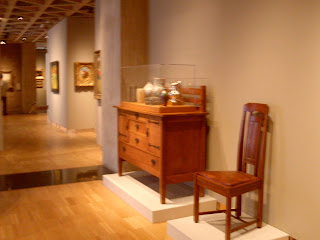Couldn’t resist another trip down town! I had some business to take care in New Haven today so while I was in the area I stopped by the Yale Art Gallery on Chapel Street. The gallery is located directly across the street from the British Art Gallery. When I began this journey at the British Art Gallery, I didn’t have enough time to visit both museums on the same day.
The Yale Art Gallery is recognized all around the world and contains renaissance art, ancient and medieval, African art, Asian Art, American art, Contemporary and much more. This building was also designed by Louis I Kahn and you can see the similarities between the two galleries. They are made from the same materials which are mirrored glass and steel, and the interior has that same earthy feel.

There are four floors with a tubular stair case in the middle and elevators if needed. I was not allowed to take pictures on four floors and other areas of the gallery. I kept asking the curators to make sure, I was told that not all the art on display is owned by Yale and therefore may not be photographed. There was no admission for this gallery but a helpful hint…turn off your cell phone the you are not allow to use them past the reception area.
The first buildings for Yale were erected in 1718. The buildings had become badly deteriorated and were knocked down in 1750 and what some remember as The Old Campus was built. Old Brick Row, as artist and designer John Trumble and many others named the first ever planned college campus was constructed. The Yale Art Gallery was founded in 1832 by Trumble and stood on the old campus from 1832-1901.

Currently on view on the fourth floor of the gallery is Picasso and the Allure of Language. There was also the Tea Culture of Japan: Chanoyu Past and Present on view January 20–April 26, 2009 on the first floor.
Monet Women in a garden Oil on Canvas 1867
(not in Yale Art Gallery)
(not in Yale Art Gallery)
An artist I was excited to see was Claude Monet. Like Van Gogh, Monet made use of lighting to add dimension to his paintings. Born in Paris in 1840, his father wanted him to work in the family grocery store but Monet wanted to be an artist. From the start of his painting career, Monet has created many paintings of Camille, who would later become his wife. Monet’s style of painting changed the way impressionistic styles of painting were created. The addition of light gave the painting depth and the feel that it was real. A popular painting from this artist is water lilies which is not in this gallery.

Waterlilies to the right not in Yale Art Gallery.

It appears in his painting of Camille on the beach, the light is coming from the upper right hand corner giving the impression the sunlight is hitting the left side of her body . You will notice Camille’s leg is crossed over the other and lighter colors have been used to show the sunlight hitting her knee. Darker tones have been used for the sand behind her and lower portions of her dress putting the sun to her left.
I was wondering how this trip would go conisidering I was on my own this time, but I ended up knowing one of the curators and was able to spend time with a friend and learn about the art in the gallery. I recommended stopping by the Yale Art Gallery, there are many beautiful things to see and there are always new exhibits showcased!
For more information follow the links below...
http://en.wikipedia.org/wiki/Claude_Monet
http://www.vangoghgallery.com/misc/bio.html
http://www.yale.edu/museums/index.html
http://en.wikipedia.org/wiki/Yale_University_Art_Gallery































 Sunday March 1, 2009
Sunday March 1, 2009







 Apparition of Face and Fruit Dish on a BeachArtist: Salvador Dalí(Spanish, 1904-1989)
Apparition of Face and Fruit Dish on a BeachArtist: Salvador Dalí(Spanish, 1904-1989)






 Robert Matta practicing automatism
Robert Matta practicing automatism

 Oliver and Abigail Wolcott Ellsworth
Oliver and Abigail Wolcott Ellsworth